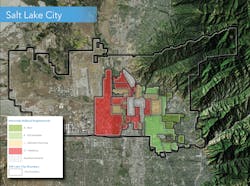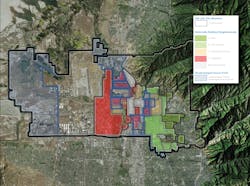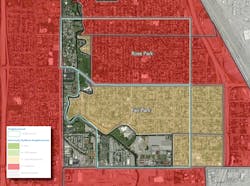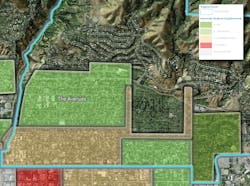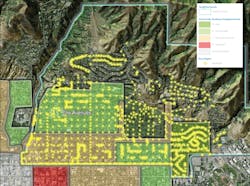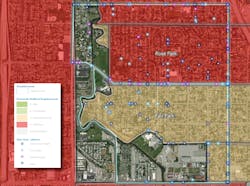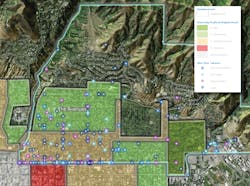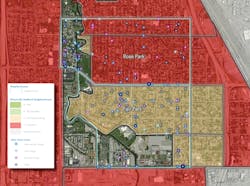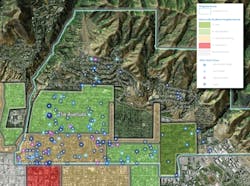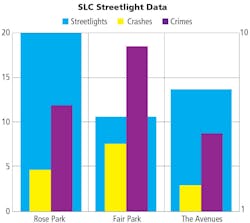INDUSTRY INSIGHTS | Shine bright, right wrongs: Revolutionize cities with quality streetlighting
Although some have heard of redlining, many have lived through it and even more are living with the consequences of it today. For those who missed this in history class, redlining was a federally backed discriminatory practice beginning in 1934 that involved denying or limiting financial services, such as loans, insurance, or access to housing, to certain individuals or communities based on their racial or ethnic background. Literal red lines drawn on maps of cities coast to coast were created by agents of the federal government’s Home Owners’ Loan Corporation. These institutions decided which people and neighborhoods would benefit from home loans, in turn generating economic mobility (or not) and determining which infrastructure improvements would be funded from local development fee revenues.
“Neighborhoods receiving the highest grade of ‘A’—colored green on the maps—were deemed minimal risks for banks and other mortgage lenders when they were determining who should receive loans and which areas in the city were safe investments. Those receiving the lowest grade of ‘D,’ colored red, were considered ‘hazardous.’” (Source: Mapping Inequality website)
Locations (buildings, infrastructure, roads, sidewalks) are not intrinsically hazardous. Redlining was about defining the people who lived in these locations. The practice was only banned as recently as 1968, and fairness in lending was assured by federal statute as late as 1975. However, since so much of our modern infrastructure spending and retooling of American cities occurred during this time, the effects are still seen today.
I cannot say I have been directly affected by the impact of racial discriminatory practices — I am unmistakably of European descent. However, I can speak about the small city of Hoboken, in Hudson County, New Jersey, where I grew up. The city of Hoboken was redlined, and mortgage lenders deemed this entire city unworthy of loans (and the opportunities that came with them) for decades. Hoboken was a working-class community of primarily immigrant and Black neighborhoods. The 1954 film On the Waterfront with Marlon Brando paints an accurate picture of life in these times.
Decades later, Hoboken is one of the premier places to live in the United States. Dubbed the “sixth borough,” it is hailed as a convenient alternative for NYC commuters, and it is the only city of its size to experience zero traffic fatalities in the last five years — something highly significant to me in my career as a traffic safety engineer.
Hoboken’s underdog story was only realized after decades of public and private investment. Prioritizing safety, building transportation alternatives, and deploying quality pedestrian-scale streetlighting has gone a long way toward improving the community. This article will demonstrate through a Salt Lake City case study how other municipalities can move out from the shadows of past labels and enable underserved neighborhoods to thrive.
Streetlighting savvy
Most people take streetlights for granted, but they affect so many facets of modern living. The majority of citizens notice outdoor lighting only when there’s a problem — a light out, flickering, or that icy indigo showing up. Many public agencies and utilities that own and operate streetlights are often happy to just keep the lights on. It is common in older cities that maintain legacy equipment and outdated infrastructure.
Most agencies I’ve dealt with have a loose understanding of where their lights are. City officials know they have streetlights, but how many, where, and other specific details are often elusive. Understanding the existing inventory sets the stage for maximizing the potential of this asset.
Streetlights bring many positive qualities to our communities when they are appropriately implemented. They prevent crashes, make it comfortable to be out after dark, help us see, and make us feel safe. However, small flaws in design can lead to significant consequences, including light trespass, sky glow, negative contrast for pedestrian crossings, ecological impacts, glare, and the feeling of being surveilled.
Still, the world has changed, and the neighborhood is far different than it was 30 years ago, let alone 50 or 60 years ago when many streetlights were installed. Behaviors have changed, too. Fewer students walk to school; more people commute by bike — the values and priorities of streetlight design were different when they were installed than they are today.
LED conversions of the last decade have presented opportunities that many agencies and utilities have not capitalized on. My firm has been on the leading edge of these conversions, inventorying and helping convert over three million streetlights to date. Such initiatives have opened up a once-in-a-generation opportunity to get lighting right.
Small changes could achieve great improvement in the design of many streetlights. A different light type (Type II versus III), a slight change in the mast-arm angle for a pedestrian crossing, or shielding away from windows or a wetland can make a substantial difference in the quality of lighting. If you’re already out in a bucket truck retrofitting your streetlights, that is an opportune time to implement improvements. The cost savings could be allocated to make equitable contributions to the lighting quality and quantity.
Case study: Salt Lake City
Collected data shows that redlined and neglected neighborhoods have considerably fewer lights, and the ones they have are of a lower quality. See an example in Salt Lake City (SLC) as follows.
Note the neighborhoods deemed “hazardous” in SLC are primarily on the west side of town, while the areas without investment restrictions are on the east side of town (Fig. 1). Many “hazardous” neighborhoods have been converted to industrial districts or razed for freeway construction.
Note in Fig. 2 that census tracts identified today as “disadvantaged” by the federal government significantly overlap with historically redlined neighborhoods.
Exploring further, comparisons can be drawn between two redlined neighborhoods in Salt Lake City — “Rose Park” (north) and “Fair Park” (south; Fig. 3, top) versus a non-redlined neighborhood, “The Avenues” (Fig. 3, bottom).
Both areas were neglected in relative terms of infrastructure projects. A few decades ago, Rose Park received urban renewal funding for additional streetlighting. On the ground, the quality and aesthetics of these streetlights are noticeably improved (Fig. 4).
The presence of improved streetlighting significantly decreased the frequency and severity of after-dark traffic crashes in the redlined neighborhoods versus The Avenues (Fig. 5).
The presence of streetlights may appear to play a role in the incidence of index crime, but the redlining legacy appears to play a larger role (Fig. 6).
Interested readers can find an interactive web map at https://tinyurl.com/IES-SLC-Lighting.
These three neighborhoods show some notable trends. As seen in Fig. 7, the number of streetlights appears to have a direct inverse correlation with the number of after-dark crashes. More streetlights resulted in fewer and less severe crashes. This is to be expected as the Federal Highway Administration (FHWA) has recently said streetlights have the ability to reduce certain types of nighttime traffic crashes by up to 42%. Conversely, the positive transportation safety trend is not replicated for after-dark index crime committed within the public right-of-way.
Although nighttime index crime is notably lower in Fair Park than in Rose Park, where there are nearly twice the streetlights, the fewest index crimes occurred in The Avenues. The Avenues was not redlined and did not have federally backed permission from banks to discourage private and public investment in these neighborhoods, and therefore provided relatively greater public resources to the members of this community.
This is one example; the data could paint a different picture in other neighborhoods or cities. The topic of whether streetlighting reduces crime is hotly debated. But the point stands. Whether that is true for specific communities requires more data to back these claims. Otherwise, all you have is a hunch.
From plan to practice
Outdoor lighting impacts so many facets of modern living. We have a responsibility to get it right. Is your neighborhood’s streetlighting in congruence with the adjacent neighborhoods? If not, how can this be resolved?
Everything has a cost, and change may require a multiyear effort in a Capital Improvement Program or a grant funded from one of the myriad programs available. Most agencies do not even have this issue on their radar. Many communities are unaware of this inequity in providing a valuable public service. If we desire to make the most of our investment in streetlighting, then it is important to place it where it is most needed.
Often, we see agencies elect a one-for-one conversion when converting to LEDs. This assumes that streetlights exist as perfect designs. In practice, this is unrealistic. Many roadway redesign projects fail to review lighting design. A road “diet” reducing lanes, adding a new bike lane, or parking removal often does not necessitate a review of the lighting.
Most of all, streetlighting decisions rely heavily on designing for typical layouts and applying these results across the unique permutations of a complex city or project. As a transportation safety professional, I often see fixed pole spacing designs as the true underlying cause of nighttime crashes. Increased flexibility in local standards may provide better lighting design and improve outcomes. Moreover, guidelines in standards that require a critical engineering review of all these various topics (context, safety, environment, and other intrinsic values) would yield the best outcomes of all.
The U.S. Department of Energy (DOE) estimates that approximately 75% of the streetlights in America are already LED. In a few years, that number is anticipated to be well over 90%.
So, what’s next? LED conversions will largely be over. The energy savings story that fueled a decade of deferred maintenance is coming to an end. How can we continue to find value in these assets as they in turn get replaced? By meeting the intrinsic goals of lighting, we can find more utility. Ultimately, a cohesive streetlight strategy centered around realizing these goals will provide a consistent and data-driven approach to long-term, evolving lighting design that meets the needs of each community and reflects the character of the natural and built environment around us. Balancing competing priorities is a challenge, but understanding local priorities, identifying infrastructure gaps, and building off project successes will direct the best practices for our communities.
ACKNOWLEDGMENT
Special thanks to Clanton & Associates for the collaborative efforts on this content, Light Justice for inspiring elements of this analysis, and Evari GIS Consulting, Inc. for developing the accompanying maps.
NICK MESLER, PE, TE, CFLC, is director of business solutions at San Diego–based Evari GIS Consulting, Inc., which offers geographic information services for urban planning.
Follow our LinkedIn page for our latest news updates, contributed articles, and commentary, and our Facebook page for events announcements and more. You can also find us on the X platform.
Nick Mesler
NICK MESLER, PE, TE, is director of business solutions at San Diego–based Evari GIS Consulting, Inc., which offers geographic information services for urban planning. A graduate of San Diego State University, Mesler focuses on traffic operations support for planning and design projects related to active transportation, citywide plans, and private development. He has GIS applicable experience in large-scale data collection, geospatial data analytics, parking demand management, community outreach, safe routes to school, traffic safety plans, and policy development.

